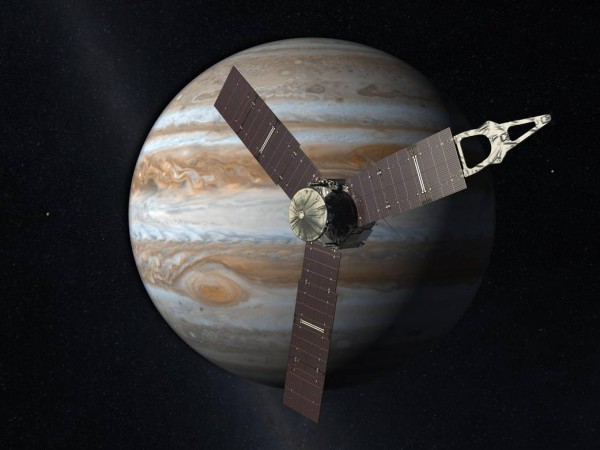NASA Juno Probe to Enter Jupiter Orbit on July 4
| Ana Verayo | | Jun 12, 2016 08:15 AM EDT |
(Photo : NASA/JPL-Caltech) Launching from Earth in 2011, the Juno spacecraft will arrive at Jupiter in 2016 to study the giant planet from an elliptical, polar orbit. Juno will repeatedly dive between the planet and its intense belts of charged particle radiation, coming only 5,000 kilometers (about 3,000 miles) from the cloud tops at closest approach.
On Friday, NASA announced that the Jupiter bound Juno spacecraft is nearing the biggest planet in the solar system, at just 11.1 million miles away or about 26 days away from its target approach date.
Like Us on Facebook
On July 4, Monday, the spacecraft will activate and produce an engine burn, blasting its main rockets for about 35 minutes, for the probe to be captured by Jupiter's gravitational forces and align itself on stable orbit near its polar regions. The probe has been travelling for five years in space since its launch.
NASA mission scientists consider this latest journey into space to be a challenging mission, since Jupiter also emits the most dangerous levels of radiation than any planet in the solar system. The Juno spacecraft is well designed and equipped with an advanced suite of scientific instruments to explore and withstand the gas giant's harsh environment and climate.
According to lead investigator for the Juno mission, Scott Bolton of the Southwest Research Institute, the probe is now scheduled to arrive and make its rendezvous soon, as Juno is speeding by at four miles every second.
Scientists expect Juno to increase its velocity as it gets closer to the colossal planet, due to its powerful gravitational forces. Upon rendezvous, the probe will achieve speeds of 40 miles per second just before it blasts off its rocket engines to be placed into orbit.
In just a few weeks, the team will be carrying out the Jupiter orbit insertion plan to determine every possible scenario upon the probe's entry into the planet's lower orbit. So far, scientists have identified two possible scenarios, when the probe emerges from its safe mode, Juno will still be operational in the event of any anomaly or unexpected atmospheric conditions. The second scenario involves executing a minor update to the probe's software.
According to project manager for Juno, Rick Nybakken, the team is now carrying out last tests and review stages of the orbit insertion plan, which is part of the final preparations for Juno's orbital entry.
Juno's main mission involves discovering the origins of Jupiter and determining clues how the gas giant evolved and formed. The probe will then collect data specifically water and ammonia levels detected on its atmosphere to determine its origins. The spacecraft will also analyze and examine gravitational and magnetic fields surrounding the planet, to also determine its core.
TagsNASA, Jupiter, juno probe, Juno spacecraft, NASA juno jupiter, jupiter probe arrivval
©2015 Chinatopix All rights reserved. Do not reproduce without permission
EDITOR'S PICKS
-

Did the Trump administration just announce plans for a trade war with ‘hostile’ China and Russia?
-

US Senate passes Taiwan travel bill slammed by China
-

As Yan Sihong’s family grieves, here are other Chinese students who went missing abroad. Some have never been found
-

Beijing blasts Western critics who ‘smear China’ with the term sharp power
-

China Envoy Seeks to Defuse Tensions With U.S. as a Trade War Brews
-

Singapore's Deputy PM Provides Bitcoin Vote of Confidence Amid China's Blanket Bans
-

China warns investors over risks in overseas virtual currency trading
-

Chinese government most trustworthy: survey
-

Kashima Antlers On Course For Back-To-Back Titles
MOST POPULAR
LATEST NEWS
Zhou Yongkang: China's Former Security Chief Sentenced to Life in Prison

China's former Chief of the Ministry of Public Security, Zhou Yongkang, has been given a life sentence after he was found guilty of abusing his office, bribery and deliberately ... Full Article
TRENDING STORY

China Pork Prices Expected to Stabilize As The Supplies Recover

Elephone P9000 Smartphone is now on Sale on Amazon India

There's a Big Chance Cliffhangers Won't Still Be Resolved When Grey's Anatomy Season 13 Returns

Supreme Court Ruled on Samsung vs Apple Dispute for Patent Infringement

Microsoft Surface Pro 5 Rumors and Release Date: What is the Latest?










